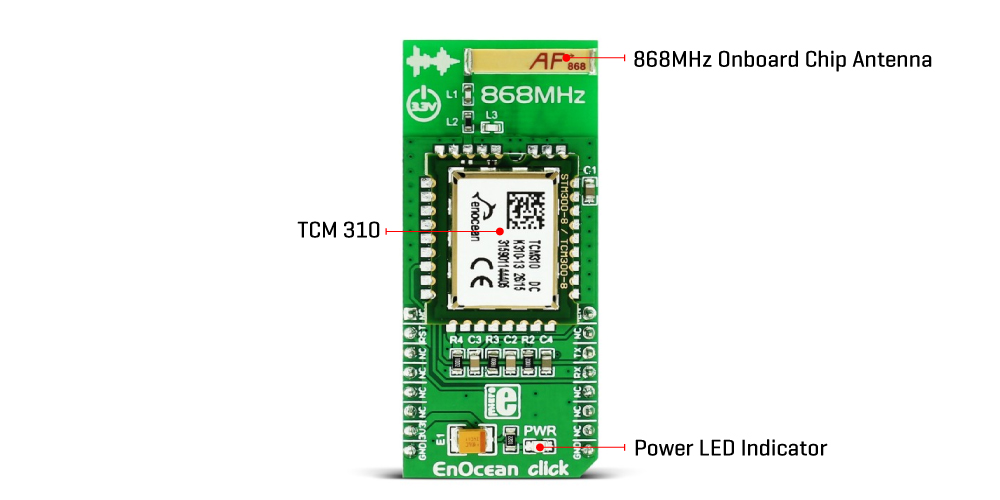OFF
GO LOCAL
| Company | Stock | Price |
|---|---|---|

MIKROE-1908
29 g
Status:
EnOcean Click is a compact add-on board that adds sub-gigahertz wireless communication to your application. This board features the TCM310, a bidirectional transceiver gateway energy harvesting module from EnOcean. The TCM310 is a power-free device that does not need a battery. It can get energy from various things in the surrounding environment, such as motion, light, or temperature differences, to harness enough power to send a wireless signal. The EnOcean module on this Click board™ operates on the EnOcean Serial Protocol 3 (ESP3), which specifies how the module communicates with the host MCU. This Click board™ makes the perfect solution for use with EnOcean’s energy harvesting modules, including self-powered, battery-free wireless switches, sensors, and actuators.
EnOcean Click is supported by a mikroSDK compliant library, which includes functions that simplify software development. This Click board™ comes as a fully tested product, ready to be used on a system equipped with the mikroBUS™ socket.
This product is no longer in stock
Availability date:
OFF
| Company | Stock | Price |
|---|---|---|

EnOcean Click is based on the TCM310, a bidirectional transceiver gateway module from EnOcean. It enables the realization of gateways for the EnOcean 868MHz radio systems by providing a bidirectional radio interface at the one end and a serial interface at the other end, with an ASK modulation type and data rate of 125Kbps. The module has low current consumption for receiving and transmitting modes with receiving sensitivity of -96dBm over the onboard 868MHz chip antenna. It generates its electrical energy by converting electromagnetic, solar, and thermoelectric energy to work as a battery-free self-powered device. The TCM310 module can act as a postmaster for up to 15 bidirectional sensors using Smart Ack technology.

The EnOcean module uses the UART interface with commonly used UART RX and TX pins as its default communication protocol for communication with the host microcontroller. In addition, this Click board™ also features read and operating modes, which can be activated using the EN pin of the mikroBUS™ socket. The operating mode is set by default with a pull-down resistor. The reset pin routed on the RST pin of the mikroBUS™ socket provides the general module-reset ability.
This Click board™ can only be operated from a 3.3V logic voltage level. Therefore, the board must perform appropriate logic voltage conversion before using MCUs with different logic levels. However, the Click board™ comes equipped with a library containing functions and an example code that can be used as a reference for further development.
Type
EnOcean,Sub-1 GHz Transceievers
Applications
Can be used for battery-free wireless industrial applications, building automation, line-powered applications, and more
On-board modules
TCM310 - transceiver gateway module from EnOcean
Key Features
Gateway for EnOcean 868 MHz radio systems, compatible with EnOcean energy harvesting modules, bidirectionalradio/serial interface, Smart Ack controller functionality, EnOcean Serial Protocol V3, programmable repeater functionality, and more
Interface
GPIO,UART
Feature
No ClickID
Compatibility
mikroBUS™
Click board size
L (57.15 x 25.4 mm)
Input Voltage
3.3V
This table shows how the pinout on EnOcean Click corresponds to the pinout on the mikroBUS™ socket (the latter shown in the two middle columns).
| Label | Name | Default | Description |
|---|---|---|---|
| LD1 | PWR | - | Power LED Indicator |
| Description | Min | Typ | Max | Unit |
|---|---|---|---|---|
| Supply Voltage | - | 3.3 | - | V |
| Operating Frequency | - | 868 | - | MHz |
| Data Rate | - | 125 | - | kbps |
| Receiver sensitivity | - | -96 | - | dBm |
| Transmission Range | 10 | - | 100 | m |
We provide a library for the EnOcean Click as well as a demo application (example), developed using MikroElektronika compilers. The demo can run on all the main MikroElektronika development boards.
Package can be downloaded/installed directly from NECTO Studio Package Manager(recommended way), downloaded from our LibStock™ or found on Mikroe github account.
Library Description
This library contains API for EnOcean Click driver.
Key functions
Response Ready function
UART Interrupt Routine function
Packet Send function.
Example Description
This example reads and processes data from EnOcean clicks.
void application_task ( void )
{
enocean_uart_isr ( &enocean );
check_response ( );
Delay_1ms( );
}
The full application code, and ready to use projects can be installed directly from NECTO Studio Package Manager(recommended way), downloaded from our LibStock™ or found on Mikroe github account.
Other Mikroe Libraries used in the example:
Additional notes and informations
Depending on the development board you are using, you may need USB UART click, USB UART 2 Click or RS232 Click to connect to your PC, for development systems with no UART to USB interface available on the board. UART terminal is available in all MikroElektronika compilers.
This Click board™ is supported with mikroSDK - MikroElektronika Software Development Kit. To ensure proper operation of mikroSDK compliant Click board™ demo applications, mikroSDK should be downloaded from the LibStock and installed for the compiler you are using.
For more information about mikroSDK, visit the official page.
NOTE: Please be advised that any peripheral devices or accessories shown connected to the Click board™ are not included in the package. Check their availability in our shop or in the YMAN section below.